-
Engine2.5L I4
-
Power182 HP / 180 LB-FT
-
TransmissionCVT
-
0-60 Time7.1 Seconds
-
DrivetrainFront-Wheel Drive
-
Curb Weight3,108 LBS
-
Seating2+3
-
Cargo15.4 CU-FT
-
MPG27 City / 38 HWY
2,500 rpm in a family sedan generally isn't a whole lot to get excited about. In fact, it's traditionally closer to idle speed than anything offering the possibility of real entertainment. But each and every one of those 2,500 revolutions in this 2013 Nissan Altima offers a frisson of excitement when whirling away in concert. Why? Because they add up to 100 mph. In a four cylinder.
Process that for a minute: 2,500 revs = 100 mph in a 2.5-liter normally aspirated four-door kinshlepper. This, friends, is impressive. We first verified the figure for ourselves during a prototype drive at Nissan's Arizona proving grounds back in March. More real-world numbers include 2,000 rpm at 80 mph and just 1,450 rpm at 60 mph. Credit the Altima's Continuously Variable Transmission, which has been extensively reworked for this new model. Seventy percent of the transmission's parts are new, and internal friction has been reduced by up to 40 percent through a battery of small tricks including redesigned internals swimming in lower viscosity oil. The transmission has a super-wide 7.0 gear ratio spread and reprogrammed control logic to help the keep all four pots on boil as necessary.
Of course, it's still a CVT, which is to driving enthusiasts what Mark Zuckerberg is to the Amish. But Nissan's Xtronic unit at least makes a good go of it, thanks to a sport mode that introduces shift points to create a physical and auditory experience similar to that of a traditional torque converter automatic. To be fair, the revs don't plunge quite as far as they would in a slushbox, but it keeps the engine in the meat of its powerband and still delivers a pretty convincing performance, even when subjected to aggressive throttle openings. Either way, those awkward "stretched rubberband" CVT moments are kept to the bare minimum, only rearing their head when the accelerator is buried in the carpet, and just for a moment. Under most circumstances, we imagine most Altima drivers probably won't even notice they own a CVT.
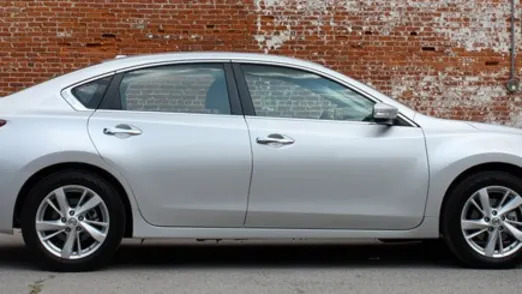
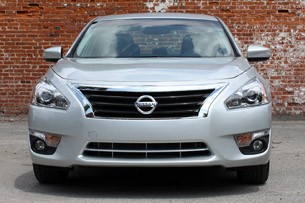
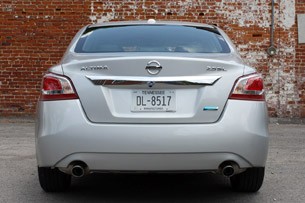
Speaking of engines, Nissan once again offers a pair of them: the QR25DE 2.5-liter four seen here, good for 182 horsepower at 6,000 rpm and 180 pound-feet of torque at 4,000 rpm, and the VQ35DE 3.5-liter V6 with 270 horses at 6,000 rpm and 258 lb-ft at 4,400 rpm. Either way, you'll get the CVT – Nissan axed the base manual transmission back in 2010.
Early rumors suggested that this fifth-generation model might go with a four-cylinder-only lineup like Hyundai, Kia and Chevrolet, but Nissan has elected to stick with updates of its current powerplants. That's not the black mark you might think it is: We have a longstanding love affair with Nissan's VQ series and the four cylinder has been a solid performer as well.The Altima has lost weight and is now the lightest car in its segment.
Thanks to other weight-saving measures throughout the car, Nissan says the Altima has lost weight and is now the lightest car in its segment – as little as 3,108 pounds. Even the top-spec SL V6 tips the scales at just 3,355 pounds, which company officials gleefully point out is lighter than all rivals – even those packing two fewer cylinders. Thus, even though Nissan has taken a pass on forced induction and direct injection, it still claims best-in-class performance and fuel economy.
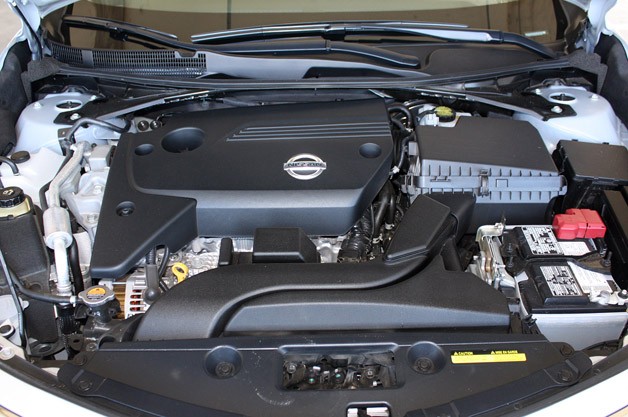
We had a second chance earlier this week to drive production-intent cars on the winding roads around Nissan North America's Nashville, Tennessee, headquarters, and chose to focus on the 2.5 liter, because consumers tend to as well – V6 models only make up about 10 percent of Altima sales. For 2013, the QR25 receives a modest seven-horsepower bump, thanks in part to variable valve timing on both intake and exhaust cams, a reworked ECU and a new intake manifold. We found the four to be a likeable drive partner, with good power and smoothness and little in the way of four-cylinder thrash, even hovering near its 6,200 rpm redline. Nissan says the four-cylinder will run to 60 mph in 7.1 seconds, which would put it at the head of its segment.Nissan isn't being shy about touting its 38 mpg highway estimate for the four-cylinder.
The headline number for this Altima isn't its 0-60 time or horsepower count, it's all about fuel economy. Nissan isn't being shy about touting its 38 miles per gallon highway estimate for the four-cylinder. In fact, it's so proud that announcements trumpeted the figure all along our bucolic drive route: giant "38 mpg" banners on hay bales, direction signs – Nissan even painted it on the side of a barn. It's a figure worth bragging about, of course, besting the upcoming 2013 Ford Fusion and 2012 Chevrolet Malibu Eco, not to mention the usual suspects from Toyota, Honda, Volkswagen and Korea Inc. Combined with an 18-gallon tank, that gives the Altima a bladder-perforating range of 680+ miles, tops in the segment. The more powerful V6 chips in with a respectable 22 mpg city and 31 mpg highway.
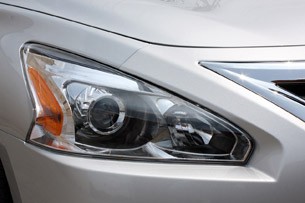
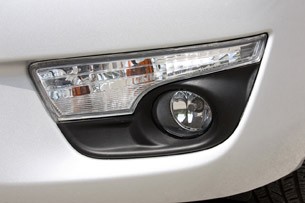
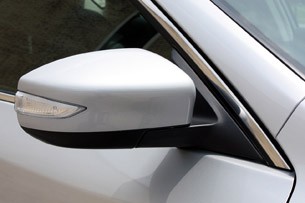
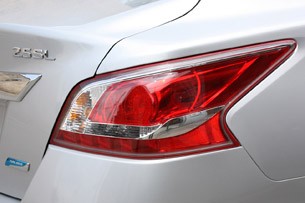
Like just about every other new family car these days, the drive for efficiency led Altima engineers to electric power steering for improved efficiency. Such setups reduce power draw on the engine but typically do so at the expense of steering feel. To combat this, Nissan's system employs a hydraulic rack powered by an electrically driven pump. The hybrid setup is a bit more complex, but a back-to-back flog with its Camry, Accord and Sonata nemeses on an Arizona handling course revealed that the hybrid setup is as mutually beneficial a relationship as Miranda Kerr and her Victoria's Secret hardware: the union results in good weighting, excellent directional accuracy and appreciably better feedback. At the end of the day, the Altima is still a front-wheel-drive family sedan riding on all-seasons rubber, but the difference is palpable.
Of course, the best steering setup in the world doesn't matter a lick if it's bolted to a chassis with more flip-flopping than an election year. Through a bit of magic (okay, strategically placed high-strength steel and a new front tower brace and rear parcel shelf reinforcement), the 2013 Altima's body weight is down while both overall size and stiffness is up. The sedan rides atop the same 109.3-inch wheelbase as last year, but its track is wider front and rear, the overall footprint is larger by about an inch in each direction, and the whole works sits about an inch lower. Suspension is still a front strut and rear multi-link array, but Nissan has spent development time and dollars where it counts: the multi-link includes novel connected bushings for better camber supervision in hard cornering and all Altimas come standard with pricy Sachs dampers as well as front and rear and anti-roll bars.The Altima quickly outs itself as one of the best-handling cars in the segment.
As before, the Altima quickly outs itself as one of the best-handling cars in the segment, with well-controlled primary and secondary impacts and nicely snubbed body control. The 2012 Altima was no slouch in the handling department, but could feel stiff-legged at times (particularly the V6). This new generation feels both better connected and more composed, with minimal body roll and a pleasingly firm comportment. We didn't hammer on them too much, but brakes (discs all 'round – 11.7-inch up front, 11.5-inch rear) also get the job done with progressive pedal feel and appropriate weighting.
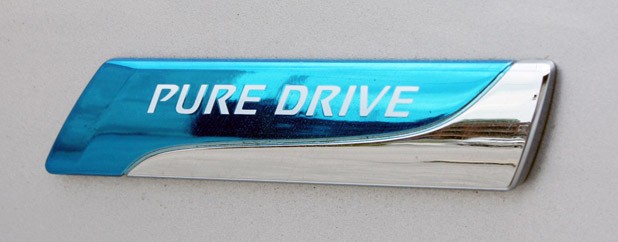
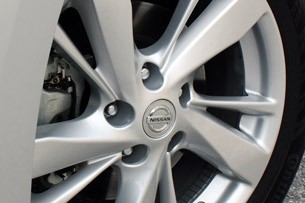
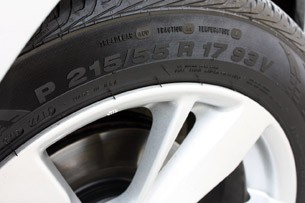
Nissan's new Active Understeer Control system won't have you hanging the tail out, a plume of low-rolling resistance rubber in your wake, but by dragging the inside front brake during hard cornering to increase yaw moment, the sedan will dig into corners with a bit more tenacity. The system cannot be independently shut off, but is extinguished when the stability control system is defeated. No matter, it's so subtle that you won't notice it at work.
Styling is best described as evolutionary, with a look that builds on the outgoing model's design while borrowing elements from Nissan's own Maxima and Infiniti M. The overall appearance strikes us as more mature than dynamic, somewhere between the opinion-splitting "look at me" raciness of the Sonata and the Teutonic sobriety of VW's Passat. Projector headlamps come standard, as do LED taillamps. Overall, we like the look, particularly the way the sunlight plays on some of the sheetmetal's deep-draw contours, but there's arguably an overreliance on chrome to communicate the car's premium aspirations, particularly in the front grille.The look strikes us as more mature than dynamic, somewhere between the racy Sonata and sober Passat.
If there were a single area where the exiting Altima needed a dramatic rethink, it was inside. While the outgoing car's ergonomics were solid, unkind plastics, middling switchgear, a tight back seat and a general lack of warmth dominated the cabin. For 2013, well-grained soft-touch plastics frame legible instruments and a well-organized center stack, and the so-called "Zero Gravity" NASA-inspired seats proved all-day comfortable and supportive in the bends. There's also a new four-inch color multi-function display sandwiched between the speedometer and tachometer that keeps tabs on everything from the trip meter to navigation and Pandora, and it's artfully canted forward for improved perspective and ease-of-focus. Rear seat space has improved, but still comes across as a bit tight for class standards, especially compared to the Passat's NBA-spec accommodations. Like the exterior, the cabin's overall aesthetic hedges toward the conservative, but given the segment, that's appropriate. As it is, the Altima's new digs are at or near the top of the class.
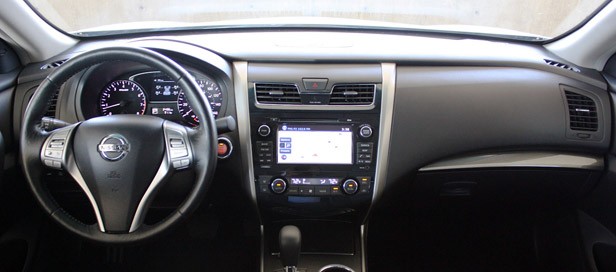
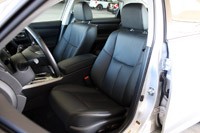
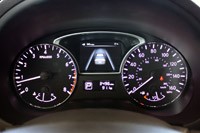
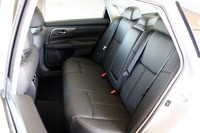
Our top-spec SL tester included everything from heated power leather seats and a moonroof to a heated steering wheel and Bose stereo, and the optional $1,090 Tech Package (navigation + blind spot, lane departure and moving obstacle detection systems) and few peripheral add-ons (rear spoiler, mud guards and floor mats) brought the as-tested price to $30,590, including $780 in delivery fees. That's a thick stack of bills, but even the base $21,500 2.5 is equipped with Bluetooth telephony and streaming audio, Easy Fill tire inflation and remote keyless entry. Nissan expects the $24,100 SV to be the volume model, and it comes with remote start, dual-zone climate control, XM, rearview camera and hands-free text messaging. 3.5 V6 models start at $25,360 and add 18-inch alloys and paddleshifters.
One other trick bit of tech is Nissan's aforementioned blind spot, lane departure and moving obstacle detection systems, all of which rely on a single wide-angle rearview camera with integrated washer and dryer. The novel setup works as advertised and is a simpler and more elegant solution than the radar-based systems that are more costly and blemish one's rear bumper with circular sensors.Make no mistake, there's a boatload of equipment here.
As well equipped as the Altima is, looking across the aisle at its competition, there are still some missing options beginning to creep into the segment, including seat cooling, rear seat heaters, panoramic moonroof and telematics (OnStar, Blue Link), and you'll have to pop for a loaded V6 in order to get Xenon headlamps. Make no mistake, though, there's still a boatload of equipment here.
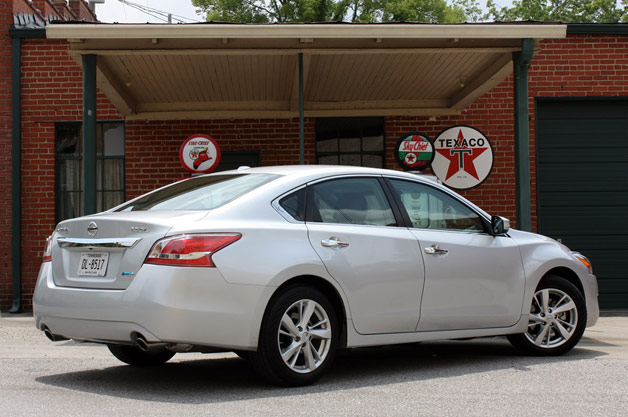
In fact, there's enough luxury character now overall that we couldn't help but wonder aloud if the newly matured Altima won't eat away at pricier Maxima sales. (Of course, we've wondered about this before, too). Nissan officials assure us that despite their mechanical and now visual similarities, Maxima buyers are very different than Altima customers, with average transaction prices around $30,000, versus around $24k for Altima. In fact, the company notes it shifted just under 60,000 Maximas last year, best in segment and handily topping rivals including the Buick LaCrosse, Toyota Avalon and Volkswagen CC, not to mention near-luxury players like the Acura TL. That's all well and good, of course, but until the next-generation Max arrives, this new V6 Altima offers a comparable (better?) interior with similar performance for a bunch less cash, so let's hope dealers don't park the two cars too close together. Speaking of related models, the Altima Coupe will soldier on into 2013 as-is, but its future remains uncertain.
Despite its status as an aging product, Nissan's old Altima quietly became America's second best-selling car behind Toyota's almighty Camry just last year. Unlike Tennessee Governor Bill Haslam, officials we spoke with are downplaying going after the sales crown, but with class-leading fuel economy, performance and massively improved accommodations, this Tennessee-built sedan clearly packs the ammunition to give Team Akio a serious run for its money. Who knows, the 2013 Altima might even snag more than its fair share of the family-minded enthusiast's dollar... CVT and all.










Sign in to post
Please sign in to leave a comment.
Continue